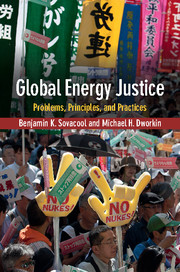Book contents
- Frontmatter
- Epigraph
- Dedication
- Contents
- Analytical table of contents
- List of figures
- List of tables
- Acknowledgements
- List of abbreviations
- 1 Introduction
- 2 The global energy system
- 3 Virtue and energy efficiency
- 4 Utility and energy externalities
- 5 Energy and human rights
- 6 Energy and due process
- 7 Energy poverty, access, and welfare
- 8 Energy subsidies and freedom
- 9 Energy resources and future generations
- 10 Fairness, responsibility, and climate change
- 11 The imperative of making just energy decisions
- Index
- References
3 - Virtue and energy efficiency
Published online by Cambridge University Press: 05 October 2014
- Frontmatter
- Epigraph
- Dedication
- Contents
- Analytical table of contents
- List of figures
- List of tables
- Acknowledgements
- List of abbreviations
- 1 Introduction
- 2 The global energy system
- 3 Virtue and energy efficiency
- 4 Utility and energy externalities
- 5 Energy and human rights
- 6 Energy and due process
- 7 Energy poverty, access, and welfare
- 8 Energy subsidies and freedom
- 9 Energy resources and future generations
- 10 Fairness, responsibility, and climate change
- 11 The imperative of making just energy decisions
- Index
- References
Summary
Pretend that the management committee of a large electric utility is reaching a point where standard projections indicate that demand from customers will soon exceed their ability to provide power. Two options have been presented to senior management. One is to spend $3 billion to build a new generating station which is expected to produce enough energy to meet demand growth for ten years at a cost of approximately 5 cents per kWh at the busbar, which would mean a cost delivered to consumers of about 8 cents per kWh. Another option is to invest $2 billion in insulating the homes and businesses of customers, which is expected to avoid the otherwise anticipated increase in demand for at least ten years, at a cost of approximately 3 to 4 cents per kWh, which with overhead will equal 4 to 5 cents per kWh on customer bills.
Which of these alternatives would you choose? Should you be affected by the fact that traditional rulemaking will grant your shareholders a high probability of earning an 8 to 10 percent return on the $3 billion investment in the power plant, while the direct expenses of insulation are recovered, but generate no return on investment?
- Type
- Chapter
- Information
- Global Energy JusticeProblems, Principles, and Practices, pp. 88 - 124Publisher: Cambridge University PressPrint publication year: 2014



